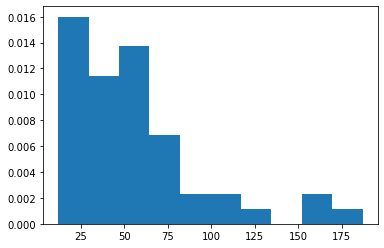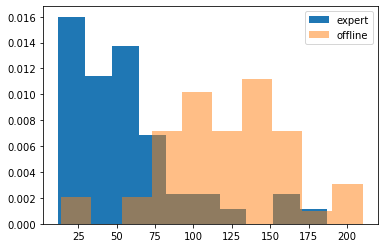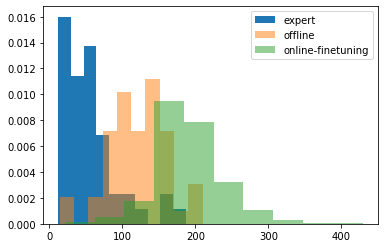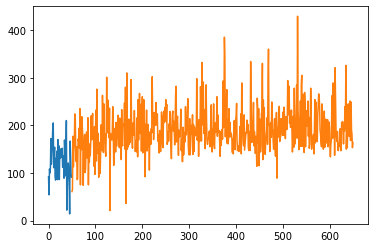- Pytorch
- gym
- matplotlib
AWAC class only supports discrete action space (Dec 30th, 2020)
(Disclaimer) I developed the codes in this repository based on the original AWAC paper. Hence, the code may contain not correct implementation of what the actual paper intended.
class AWAC(nn.Module):
def __init__(self,
critic: nn.Module, # Q(s,a)
critic_target: nn.Module,
actor: nn.Module, # pi(a|s)
lam: float = 0.3, # Lagrangian parameter
tau: float = 5 * 1e-3,
gamma: float = 0.9,
num_action_samples: int = 1,
critic_lr: float = 3 * 1e-4,
actor_lr: float = 3 * 1e-4,
use_adv: bool = False):critic: State-action value function Q(s,a)critic_target: the target network of Q(s,a)actor: An discrete actor. Note that the output ofactoris logit.lam: Lagrangian parameter of the AWAC actor loss. Assume to be a strictly positive value.tau: the Polyak parameter for updating the target network.gamma: The discount factor of target MDPnum_action_samples: Number of action samples for updating critic.critic_lr: Learning rate of criticactor_lr: Learning rate of actoruse_adv: IfTrue, use advantage value for updating actor. Else use Q(s,a) for updating actor.
You can find the running example of AWAC on gym cartpole-v1 environment from AWAC-example.ipynb.
It is confirmed that AWAC can learn better policy than its behavior policy in offline mode.
- Prepare the offline dataset by using a good enough DQN (well trained but with a 40% chance act randomly)
- 50 independent
cartpole-v1trial were made.
- The values on the x-axis show how long each episode was. (Longer is better)
- The values on the y-axis indicate the frequency of the episode lengths.
- After training 8000 gradient steps with 1024 sized mini-batch,
AWACwas able to learn a policy better than the one ofgood enough DQN.
- The blue distribution shows the performance distribution of the
good enough DQN. - The orange distribution shows the performance distribution of the offline trained
AWAC.
- After
AWACtrained on 600 episode amount of online training,AWACshows even better control performance. (offline trainedAWAC+ 600 ep online training)
- Moreover, the
AWACdidn't show the 'dip', a phenomenon that indicates sudden performance drop right after online training
-
The blue curve shows the performance of
AWACtrained on the offline dataset only -
The orange curve shows the performance of
AWACtrained in online mode. i.e., the samples from replay memory would contain some amount of distributional shift. -
Also confirmed that even we clear the memory right before start to online training, the
AWACstill can learn well.



